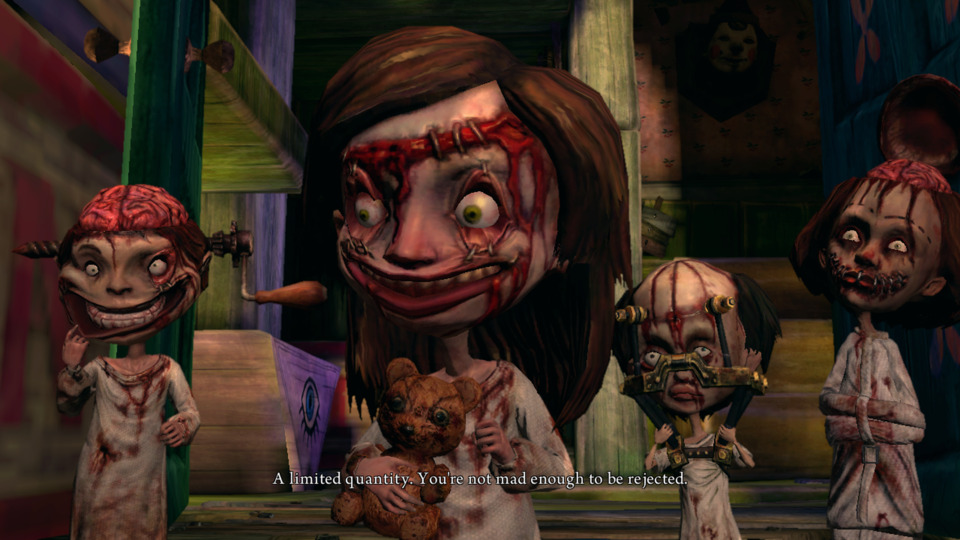Schlocktober '21: Alice: Madness Returns is a macabre cult classic that's still worth your time during spooky season.
By bigsocrates 3 Comments
SCHLOCKTOBER '21: This October I have been playing a number of games with Halloween appropriate themes, focusing on older and less appreciated games in my backlog. These aren't necessarily horror games but rather games with strong horror elements. I've decided to blog about these games and whether I think they're still worth playing as a seasonal treat or the gaming equivalent of an apple full of razor blades.
I started Alice: Madness Returns a few days after finishing the original Alice, and the advances in 3D gaming in the 11 years between the games were incredible. The first Alice game feels like an old relic with art design that holds up and platforming that can deliver a hit of nostalgia, but not much else to recommend it.
Madness Returns certainly looks like an Xbox 360 game, but it’s still gorgeous and it plays beautifully. The difference between 2000 and 2011 is immeasurably greater than between 2011 and today. 3D gaming was still figuring itself out in 2000. By 2011 it had matured. There’s a reason we get so many 7th gen games remastered for today’s consoles, and it’s because they still play great. Madness Returns has a clunky camera that could probably use a rework, and it sags during its scenes set in “real world” England, but everything else about it holds up.
Madness Returns’ story takes place a few years after the end of the first Alice. In that game we saw Alice happily leaving the asylum, seemingly having purged her demons during her trip through the warped Wonderland and ready to start a new life. In this game we see what that new life actually is, and it’s just as grim as the old one. She has been taken in by a doctor who is trying to help her forget her trauma rather than coping with it, and over the course of the game’s real world segments you meet a number of other people who have exploited her over the years, such as the corrupt lawyer who handled her family’s estate and clearly filled his own pockets during the process.
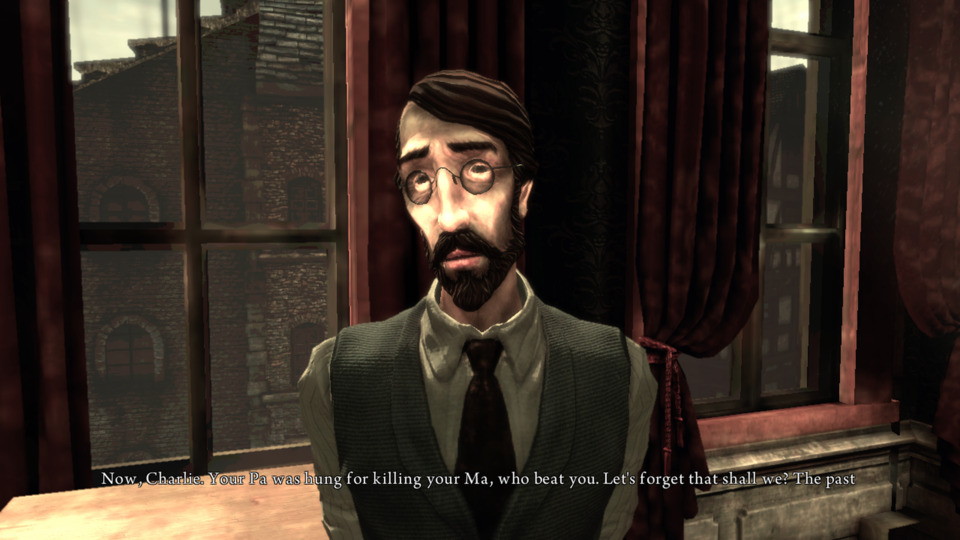
These London segments are grim and grimy. You can’t do much as Alice, just wander about trying to find your way to the end of the segment or triggering a few optional conversations, but everyone you meet is terrible. There are themes of sexual exploitation and child abuse and neglect, and they aren’t handled particularly well, especially because they’re being used to establish mood and are not the focus of the game. I didn’t enjoy these parts and I don’t think it’s a great look to use those kinds of things just for shock value. This is not really a game about psychological damage, it’s an action platformer, and there are ways to establish a grim mood without bringing the rape of young children into the mix.
That being said, things get much better when you reach Wonderland. The grimness of England does help you understand why Alice created this fantasy world to escape to, and you feel the same relief she does when you finally get back there and away from all the sordidness of the real world segments. If Wonderland was an artistic triumph given technical limitations in 2000, now it’s just a gorgeous fantasy landscape bursting with creativity. You start out in a pretty typical rural fantasy area but soon you’re clambering through the machinery of an impossible industrial city, leaping in between card castles suspended in the sky, and traversing moonlit ice floes. The environments in this game are just a joy, and even when they become more and more horrific as you get deeper in they are still gorgeous and creative. Again the art design is the standout feature.
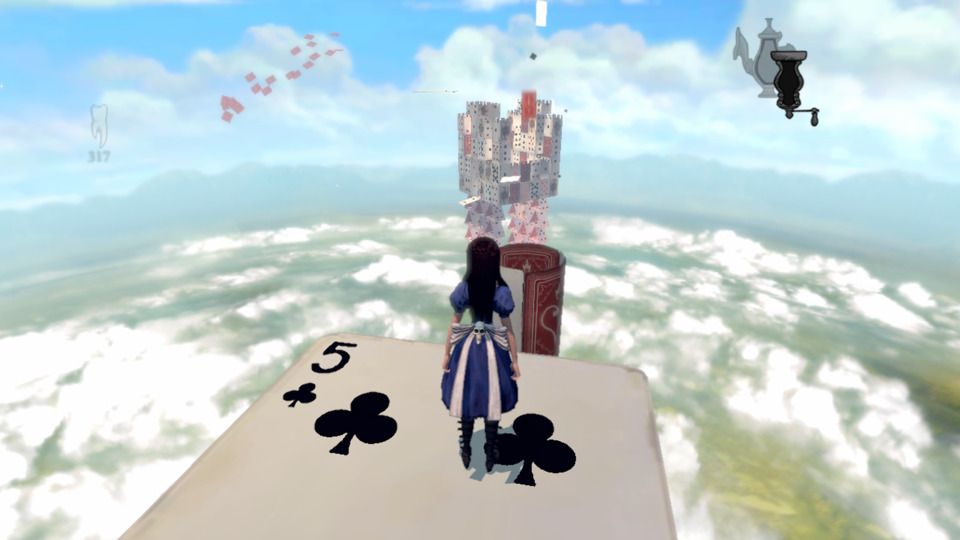
If the first game’s story was decent for the time the second game has a better narrative, though in 2011 it would be less of a standout in an industry that had already seen games like Mass Effect and BioShock. The gist of it is that Wonderland is under attack again, this time from a demonic train, and Alice must save it. Characters who died in the first game are back in the second (fair enough, considering this is a literal fantasy world) and this time they have real personalities and motivations instead of just weird things to say. It’s a much more cohesive story that blends the real world and the fantasy and it’s decently done. I wouldn’t suggest anyone play this game for the story, but it definitely adds to the proceedings and doesn’t drag down the pacing.
The gameplay itself is simple but fun. You control Alice and she can run, jump, slide down inclines, and glide, pushed upwards by drafts of air. It plays somewhat similar to the first game except that it’s clearly been designed for an analog controller rather than mouse and keyboard so the controls feel much better. Combat has been completely overhauled. The first game’s 10 weapons have been stripped down to four, and each weapon now only has one attack. You get the vorpal blade, a hobby horse that acts like a giant hammer, a peppermill that’s like a machine gun, and a mortar shot. The two ranged weapons don’t take ammo but do overheat, and both the melee weapons can be used as much as you want. You also have a lock on button now meaning that no longer are you flailing about uselessly. Enemies can block attacks and have exploitable weaknesses so combat is about locking on and either staying at range and hitting them with the peppermill or darting in to do close up battle and making liberal use of Alice’s dodge to keep her safe. It’s not deep enough to carry the whole game and it does get tedious after a while, but given that the game is probably 60% platforming and 40% combat it’s acceptable. The platforming is definitely the gameplay highlight and it features some innovative ideas like having a lot of platforms that are invisible but can be seen when Alice activates her shrink ability (which she can do at will and also uses to get through small openings.) This means that much of the platforming, especially in areas where you’re going for optional collectables, is about seeing the platforms and remembering where they are and how they’re moving. It can be a bit frustrating but it’s also an interesting take on a genre that’s been done to death. It’s obviously not the first 3D platformer with invisible platforms but it’s the only one I can remember that makes such extensive use of them.
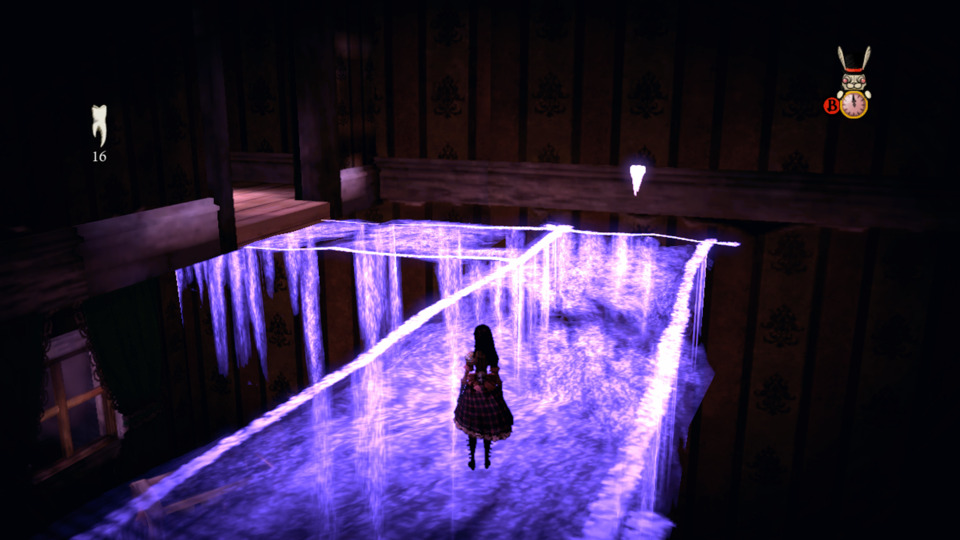
Of course because this is a game from 2011 there are a number of minigames. There are a few bad 2D platforming sections, a pretty bad submarine minigame, and some optional survival arenas where you can earn a bit of an extra rose (this game’s version of hit points.) None of these are great but they’re short and fairly harmless except for the 2D platforming, which happens 3 times in relatively quick succession and makes the game’s pace drag. It doesn’t help that the game in general is just flat out too long for what it offers. There are five main chapters and each features at least two major environments, but even though there’s some enemy variety and your abilities do evolve over time, it’s just a bit too simple to justify its dozen hour run time. It’s never boring, but it would have been a better game if it were a bit leaner and less repetitive. This also goes for the collectibles. At first it’s fun to find all the memories scattered around, each one playing a snippet of dialog and filling in a detail, but they don’t do anything, and the messages in a bottle only unlock artwork if you collect all of them of a given color in a given world (and even then it’s just artwork.) You can also find teeth, which are the game’s upgrade currency, but if you scour the levels you’ll soon have all the available weapon upgrades and I think by the end of world 3 they were completely useless to me. Many of the secrets are hidden behind floating pig snouts that you have to pepper to get them to open a path for you, and it’s fun to try to track down the source of the snorting when you’re near one, but doing that only to find a useless reward soon grows old. The game needed more useful things to find or more things to buy if it were going to be as packed with secrets as it is.

In terms of seasonal appropriateness, if the first Alice game had horror influences I think that by the end this one is flat out a horror game. The brighter earlier environments contrast with the spookiness you find later, and by the end the narrative themes are pitch black and explicit. You learn about Alice’s trauma and her catatonic state during the first game, as well as the horrors of the asylum. You learn about what really happened in the family fire. You battle zombies and creepy evil dolls. Madness returns is a title that can be read many ways. It is a statement of fact, a description of the game’s set up, and a way of looking at the game’s progression itself.
American McGee has talked about making a third Alice game and I’m not even sure what that looks like in the 2020s. They just don’t make these kinds of high budget action platformers anymore, at least outside of the pillar franchises and especially not for adults. They barely make single player complete experiences anymore. It would have to tell a different story and in a more subtle and nuanced way and the gameplay would have to be overhauled again in an age where the standard bearers for mainstream action are games like God of War 2018 and Ghosts of Tsushima.
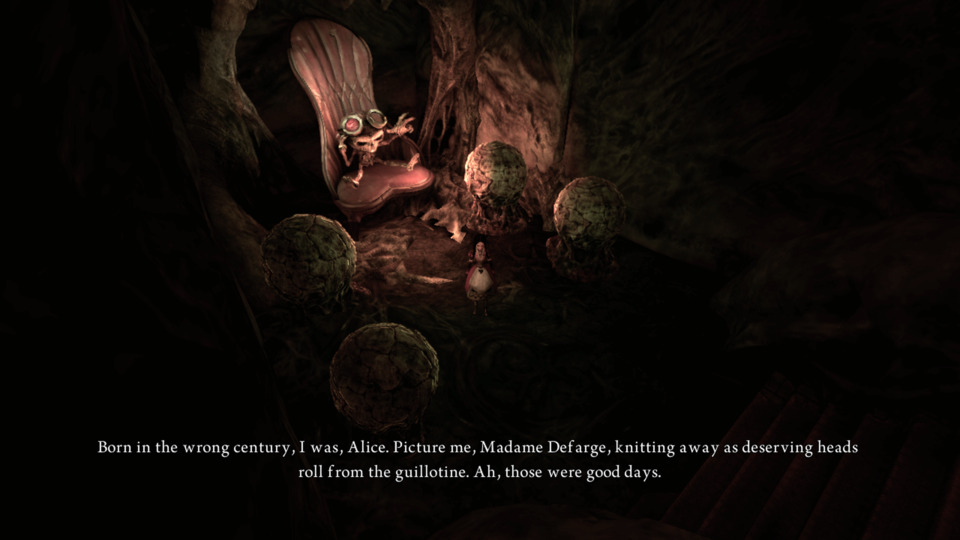
Nonetheless I’d like to see the series continue. Part of this is just that I love 3D platformers and those are still relatively rare, despite having made a small resurgence in recent years, and adult themed 3D platformers are very unusual indeed. Part of it is just that I love the aesthetic of Wonderland and would really enjoy another set of environments to explore. I did not grow attached to the characters in this game and I don’t really care about the story, but there is virtually limitless creativity in the places you get to visit and I’d like to see more of that. I doubt we will, but at least it’s being discussed.
Schlocktober Rating: Fascinating Schlock.
Alice: Madness Returns is a game with a lot of issues but that achieves so much with its aesthetic and unusual subject matter for its genre that it’s really unlike anything else I’ve played. That alone was enough to make it compelling, even when the combat felt repetitive or the secrets unrewarding. As a candy I would compare it to some exotic weirdo one off, like rosehip Skittles or a hibiscus Starburst. Some strange combination of flavors that doesn’t work as well as the standard strawberry and lemon but that gets by on sheer novelty. The gameplay is familiar and competent but the world really is worth experiencing, regardless of whether you played the first game, which didn’t have much of a story to begin with. It’s like a Terry Gilliam movie. The creativity is powerful enough to overwhelm all the negatives and make it a worthwhile use of time.
